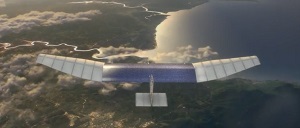Facebook’s High-Flying Idea
Facebook, like Google, is developing ways to deliver Internet access across the globe using methods that quite literally are up in the air.
While Google has Project Loon, an initiative that aims to deliver 3G-like speeds via an array of solar-powered balloons, Facebook has the Internet.org partnership and the recently formed Connectivity Lab team that is developing a mix of airborne methods that provide Internet connectivity via drones and low-earth orbit satellites armed with lasers, with each tailored to deliver Internet connectivity to areas with varying population densities.
Through Internet.org, Facebook and its partners have helped 3 million new people gain access to the Internet in the Philippines and Paraguay, Facebook chief Mark Zuckerberg said in this post. “[B]ut connecting the whole world will require inventing new technology too. That’s what our Connectivity Lab focuses on, and there’s a lot more exciting work to do here,” he added.
o reach broad, low-density areas, Facebook is looking into using an interconnected fleet of satellites that establish a flying Internet backbone tied together with free-space optics, which creates high-capacity data links over infrared laser beams. Historically, FSO has been applied a lot closer to the ground but it has some shortcomings – it performs poorly in fog because it disrupts the laser beams.
The good news for Facebook – fog isn’t a huge concern in the lofty regions it’s targeting with these high-flying ideas.
In higher-density, suburban scenarios, Facebook is considering a network of high-altitude drones that soar above the weather at about 60,000 feet, and also rely on FSO technology. Facebook has tapped Ascenta, a U.K.-based company that specializing in high-altitude long-endurance (HALE) aircraft, to assist with this part of the project. TechCrunch reported earlier this month that Facebook is in talks to buy Titan Aerospace, a maker of the sort of solar-powered unmanned planes that will be used for this budding Internet access initiative.

Because these drones are solar-powered, they can stay aloft for “months at a time,” Yael Maguire, engineering for the Facebook Connectivity Lab, said in the a brief video below that explains the project.
Similar in aim to Google’s Project Loon, Facebook’s initiative aims to bring Internet connectivity to what it estimates to be two-thirds of the world’s population that doesn’t have it.
While the do-gooder aims of these initiatives (not to mention the pure business aspects of them) deserve some praise, I also wonder if these announcements are also cause for concern for satellite broadband providers such as ViaSat, while also getting cellular service providers to at least crane their necks to see what Facebook is up to.
Multichannel Newsletter
The smarter way to stay on top of the multichannel video marketplace. Sign up below.
